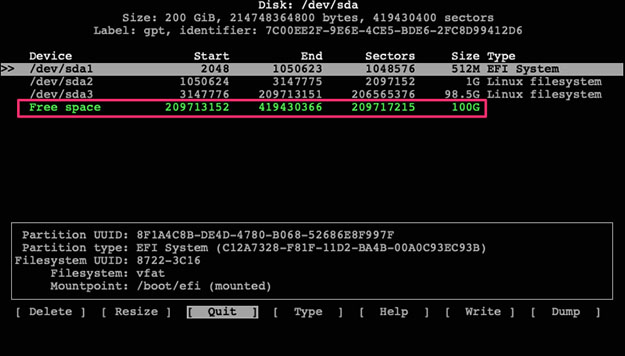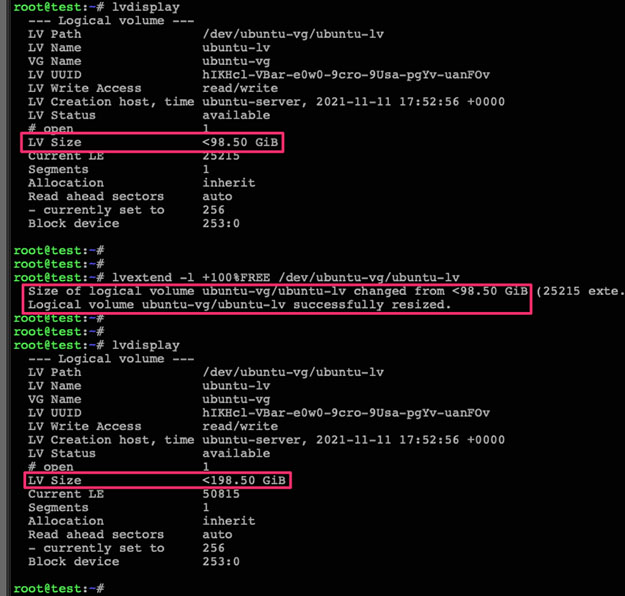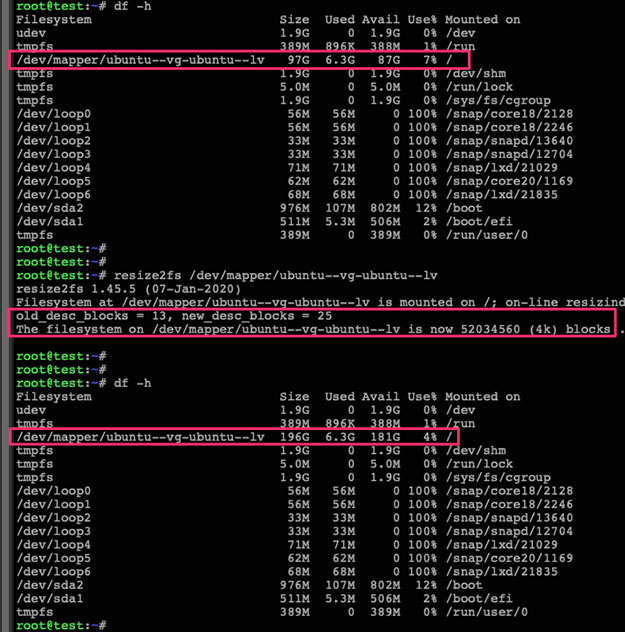Updated: 12-Dec-2024
Sources: 1 https://pve.proxmox.com/wiki/Resize_disks, 2 https://packetpushers.net/blog/ubuntu-extend-your-default-lvm-space/
I’m writing this down because I do this about every six months and spend a day looking it up and breaking stuff every time. I use LVM and ext4 file system in my VMs.
Expansion Process
If I enlarge the hard disk, once I have added the disk plate, my partition table and file system knows nothing about the new size, so I have to act inside the VM to fix it.
If I reduce (shrink) the hard disk, of course removing the last disk plate will probably destroy my file system and remove the data in it! So in this case it is paramount to act in the VM in advance, reducing the file system and the partition size. SystemRescueCD comes very handy for it, just add its iso as cd-rom of my VM and set boot priority to CD-ROM.
Shrinking disks is not supported by the PVE API and has to be done manually.”
1. Resizing guest disk
qm command (or use the resize command in the GUI)
You can resize my disks online or offline with command line:
qm resize <vmid> <disk> <size>
example: to add 5G to my virtio0 disk on vmid100:
qm resize 100 virtio0 +5G
For virtio disks, Linux should see the new size online without reboot with kernel >= 3.6
2. Enlarge the partition(s) in the virtual disk
We will assume I am using LVM on the storage and the VM OS is using ext4 filesystem.
Online for Linux Guests
Here we will enlarge a LVM PV partition, but the procedure is the same for every kind of partitions. Note that the partition I want to enlarge should be at the end of the disk. If I want to enlarge a partition which is anywhere on the disk, use the offline method.
Check that the kernel has detected the change of the hard drive size (here we use VirtIO so the hard drive is named vda)
bash dmesg | grep vda
[3982.979046] vda: detected capacity change from 34359738368 to 171798691840
Example with EFI
Print the current partition table
fdisk -l /dev/vda | grep ^/dev GPT PMBR size mismatch (67108863 != 335544319) will be corrected by w(rite). /dev/vda1 34 2047 2014 1007K BIOS boot /dev/vda2 2048 262143 260096 127M EFI System /dev/vda3 262144 67108830 66846687 31.9G Linux LVM
Resize the partition 3 (LVM PV) to occupy the whole remaining space of the hard drive)
parted /dev/vda (parted) print Warning: Not all of the space available to /dev/vda appears to be used, I can fix the GPT to use all of the space (an extra 268435456 blocks) or continue with the current setting? Fix/Ignore? F (parted) resizepart 3 100% (parted) quit
Example without EFI
Another example without EFI using parted:
parted /dev/vda (parted) print Number Start End Size Type File system Flags 1 1049kB 538MB 537MB primary fat32 boot 2 539MB 21.5GB 20.9GB extended 3 539MB 21.5GB 20.9GB logical lvm
Resize the 2nd partition, first (extended):
(parted) resizepart 2 100% (parted) resizepart 3 100%
Check the new partition table
(parted) print Number Start End Size Type File system Flags 1 1049kB 538MB 537MB primary fat32 boot 2 539MB 26.8GB 26.3GB extended 3 539MB 26.8GB 26.3GB logical lvm (parted) quit
3. Enlarge the filesystem(s) in the partitions on the virtual disk
If I did not resize the filesystem in step 2
Online for Linux guests with LVM
Enlarge the physical volume to occupy the whole available space in the partition:
pvresize /dev/vda3
List logical volumes:
lvdisplay
--- Logical volume ---
LV Path /dev/{volume group name}/root
LV Name root
VG Name {volume group name}
LV UUID DXSq3l-Rufb-...
LV Write Access read/write
LV Creation host, time ...
LV Status available
# open 1
LV Size <19.50 GiB
Current LE 4991
Segments 1
Allocation inherit
Read ahead sectors auto
- currently set to 256
Block device 253:0
I’ve noted that in Ubuntu Server the Volume Group Name does not end in root as Ubuntu Desktop does.
Here is Ubuntu Server
--- Logical volume --- LV Path /dev/ubuntu-vg/ubuntu-lv LV Name ubuntu-lv VG Name ubuntu-vg LV UUID DoMD3y-0lmV-osy5-mwOj-hMs9-ruaV-S8ufTu LV Write Access read/write LV Creation host, time ubuntu-server, 2022-01-24 21:59:57 +0000 LV Status available # open 1 LV Size <66.00 GiB Current LE 16895 Segments 1 Allocation inherit Read ahead sectors auto - currently set to 256 Block device 253:0
and here is Ubuntu Desktop (Ubuntu Mate)
--- Logical volume --- LV Path /dev/vgubuntu-mate/root LV Name root VG Name vgubuntu-mate LV UUID Z270jO-SCGC-cttK-Vtac-m2gF-zILg-dPA9xO LV Write Access read/write LV Creation host, time ubuntu-mate, 2023-11-19 18:59:16 -0500 LV Status available # open 1 LV Size <55.77 GiB Current LE 14276 Segments 1 Allocation inherit Read ahead sectors auto - currently set to 256 Block device 252:0
Enlarge the logical volume and the filesystem (the file system can be mounted, works with ext4 and xfs). Replace “{volume group name}” with my specific volume group name:
This command will increase the partition up by 20GB
lvresize --size +20G --resizefs /dev/{volume group name}/root
Use all the remaining space on the volume group
lvresize --extents +100%FREE --resizefs /dev/{volume group name}/root
Online for Linux guests without LVM Enlarge the filesystem (in this case root is on vda1) An ext4 file system may be grown while mounted using the resize2fs command:
resize2fs /mount/device size
resize2fs /dev/vda1
From the second article
For just Ubuntu/Debian and assumes there is free space in the partition
See the second link above. The default Ubuntu installer settings may not use my entire root partition available to it. So I may use these commands to expand the usable space to grab up all the free space that may be left in the partition.
A. Start by checking my root filesystem free space with df -h
Here I am using 32% or 20GB/65GB of the file System
jcz@lamp:~$ df -h Filesystem Size Used Avail Use% Mounted on tmpfs 383M 1.7M 381M 1% /run /dev/mapper/ubuntu--vg-ubuntu--lv 65G 20G 43G 32% / tmpfs 1.9G 0 1.9G 0% /dev/shm tmpfs 5.0M 0 5.0M 0% /run/lock /dev/vda2 974M 182M 725M 21% /boot tmpfs 382M 12K 382M 1% /run/user/1000
B. Check for existing free space on my Volume Group, run the command vgdisplay and check for free space. Here I can see I have 16.00 GiB of free space (Free PE) ready to be used. If I don’t have any free space, move on to the next section to use some free space from an extended physical (or virtual) disk.
root@pbs:~# vgdisplay --- Volume group --- VG Name pbs System ID Format lvm2 Metadata Areas 1 Metadata Sequence No 3 VG Access read/write VG Status resizable MAX LV 0 Cur LV 2 Open LV 2 Max PV 0 Cur PV 1 Act PV 1 VG Size <199.00 GiB PE Size 4.00 MiB Total PE 50943 Alloc PE / Size 46847 / <183.00 GiB Free PE / Size 4096 / 16.00 GiB <--- VG UUID pUCnBq-dYv7-wN3m-NTvy-XFwD-YT2e-UOku16
C. Use up any free space on my Volume Group (VG) for my root Logical Volume (LV), first run the lvdisplay command and check the Logical Volume (LV) size, then run lvextend -l +100%FREE /dev/ubuntu-vg/ubuntu-lv to extend the LV (from the LV Path) to the maximum size usable, then run lvdisplay one more time to make sure it changed.
root@pbs:~# lvdisplay --- Logical volume --- LV Path /dev/pbs/root LV Name root VG Name pbs LV UUID 80mBRo-cMoc-OIST-hn7j-ootY-dH8E-TghShK LV Write Access read/write LV Creation host, time proxmox, 2024-11-17 16:05:04 -0500 LV Status available # open 1 LV Size <179.00 GiB <--- Current LE 45823 Segments 1 Allocation inherit Read ahead sectors auto - currently set to 256 Block device 252:1
Let’s use up the remaining free space
root@pbs:~# lvdisplay root@pbs:~# lvextend -l +100%FREE /dev/pbs/root Size of logical volume pbs/root changed from <179.00 GiB (45823 extents) to <195.00 GiB (49919 extents). Logical volume pbs/root successfully resized.
That seemed to work. Let’s check it to verify.
root@pbs:~# lvdisplay
--- Logical volume ---
LV Path /dev/pbs/root
LV Name root
VG Name pbs
LV UUID 80mBRo-cMoc-OIST-hn7j-ootY-dH8E-TghShK
LV Write Access read/write
LV Creation host, time proxmox, 2024-11-17 16:05:04 -0500
LV Status available
# open 1
LV Size <195.00 GiB
Current LE 49919
Segments 1
Allocation inherit
Read ahead sectors auto
- currently set to 256
Block device 252:1
D. Now I have increased the size of the block volume where the root filesystem resides, but I still need to extend the filesystem on top of it. First, I will run df -h to verify my (almost full) root file system, then I will run resize2fs /dev/mapper/pbs-root to extend my filesystem, and run df -h one more time to make sure I’m successful. of course I’m using Debian here as installed on a test instance of Proxmox Backup Server that I’m going to blow away.
root@pbs:~# df -h Filesystem Size Used Avail Use% Mounted on udev 1.9G 0 1.9G 0% /dev tmpfs 382M 692K 381M 1% /run /dev/mapper/pbs-root 176G 2.0G 165G 2% / tmpfs 1.9G 0 1.9G 0% /dev/shm tmpfs 5.0M 0 5.0M 0% /run/lock efivarfs 256K 60K 192K 24% /sys/firmware/efi/efivars /dev/sda2 1022M 12M 1011M 2% /boot/efi tmpfs 382M 0 382M 0% /run/user/0
OK, below looks good!
root@pbs:~# resize2fs /dev/mapper/pbs-root resize2fs 1.47.0 (5-Feb-2023) Filesystem at /dev/mapper/pbs-root is mounted on /; on-line resizing required old_desc_blocks = 23, new_desc_blocks = 25 The filesystem on /dev/mapper/pbs-root is now 51117056 (4k) blocks long. root@pbs:~# df -h Filesystem Size Used Avail Use% Mounted on udev 1.9G 0 1.9G 0% /dev tmpfs 382M 692K 381M 1% /run /dev/mapper/pbs-root 191G 2.0G 180G 2% / tmpfs 1.9G 0 1.9G 0% /dev/shm tmpfs 5.0M 0 5.0M 0% /run/lock efivarfs 256K 60K 192K 24% /sys/firmware/efi/efivars /dev/sda2 1022M 12M 1011M 2% /boot/efi tmpfs 382M 0 382M 0% /run/user/0
Great! I just allocated the free space left behind by the installer to my root filesystem. If this is still not enough space, I will continue on to the next section to allocate more space by extending an underlying disk.
Use Space from Extended Physical (or Virtual) Disk
*Using examples from the author *
A. First I might need to increase the size of the disk being presented to the Linux OS. This is most likely done by expanding the virtual disk in KVM/VMWare/Hyper-V or by adjusting my RAID controller / storage system to increase the volume size. You can often do this while Linux is running; without shutting down or restarting.
B. Once that is done, I may need to get Linux to rescan the disk for the new free space. Check for free space by running cfdisk and see if there is free space listed, use “q” to exit once I’re done.
If I don’t see free space listed, then I initiate a rescan of /dev/sda with echo 1>/sys/class/block/sda/device/rescan . Once done, rerun cfdisk and I should see the free space listed.
C. Select my /dev/sda3 partition from the list and then select “Resize” from the bottom menu. Hit ENTER and it will prompt me to confirm the new size. Hit ENTER again and I will now see the /dev/sda3 partition with a new larger size.
- Select “Write” from the bottom menu, type yes to confirm, and hit ENTER. Then use “q” to exit the program.
D. Now that the LVM partition backing the /dev/sda3 Physical Volume (PV) has been extended, we need to extend the PV itself. Run pvresize /dev/sda3 to do this and then use pvdisplay to check the new size.
As I can see above, my PV has been increased from 98.5GB to 198.5GB. Now let’s check the Volume Group (VG) free space with vgdisplay.
We can see above that the VG has 100GB of free space. Now let’s check the size of our upstream Logical Volume (LV) using lvdisplay.
E. Now we extend the LV to use up all the VG’s free space with lvextend -l +100%FREE /dev/ubuntu-vg/ubuntu-lv, and then check the LV one more time with lvdisplay to make sure it has been extended.
F. At this point, the block volume underpinning our root filesystem has been extended, but the filesystem itself has not been resized to fit that new volume. To do this, run df -h to check the current size of the file system, then run resize2fs /dev/mapper/ubuntu–vg-ubuntu–lv to resize it, and df -h one more time to check the new file system available space.
And there I go. I’ve now taken an expanded physical (or virtual) disk and moved that free space all the way up through the LVM abstraction layers to be used by my (critically full) root file system.
Other useful commands and their output
fdisk -l Disk /dev/vda: 67 GiB, 71940702208 bytes, 140509184 sectors Units: sectors of 1 * 512 = 512 bytes Sector size (logical/physical): 512 bytes / 512 bytes I/O size (minimum/optimal): 512 bytes / 512 bytes Disklabel type: gpt Disk identifier: D1A6933C-7817-4756-AA1B-5D924F3054B0 Device Start End Sectors Size Type /dev/vda1 2048 4095 2048 1M BIOS boot /dev/vda2 4096 2101247 2097152 1G Linux filesystem /dev/vda3 2101248 140509150 138407903 66G Linux filesystem Disk /dev/mapper/ubuntu--vg-ubuntu--lv: 66 GiB, 70862766080 bytes, 138403840 sectors Units: sectors of 1 * 512 = 512 bytes Sector size (logical/physical): 512 bytes / 512 bytes I/O size (minimum/optimal): 512 bytes / 512 bytes
lsblk NAME MAJ:MIN RM SIZE RO TYPE MOUNTPOINTS loop0 7:0 0 1.9M 1 loop /snap/bottom/759 loop1 7:1 0 4K 1 loop /snap/bare/5 loop2 7:2 0 1.9M 1 loop /snap/btop/655 loop3 7:3 0 9.6M 1 loop /snap/canonical-livepatch/246 loop4 7:4 0 105.8M 1 loop /snap/core/16202 loop5 7:5 0 63.9M 1 loop /snap/core20/2105 loop6 7:6 0 74.1M 1 loop /snap/core22/1033 loop7 7:7 0 152.1M 1 loop /snap/lxd/26200 loop8 7:8 0 40.4M 1 loop /snap/snapd/20671 vda 252:0 0 67G 0 disk ├─vda1 252:1 0 1M 0 part ├─vda2 252:2 0 1G 0 part /boot └─vda3 252:3 0 66G 0 part └─ubuntu--vg-ubuntu--lv 253:0 0 66G 0 lvm /
Volume and Partition Commands
growpart /dev/sda 3
pvresize /dev/sda3
lvextend -l +100%FREE /dev/pve/root
resize2fs /dev/mapper/pve-root
-
Try also
vgsvgs — Display information about volume groups. Add -v or -vv or -vvv to see more details. Andlvslvs — Display information about logical volumes, also with -v and -vv to see more. -
Note that lvresize can be used for both shrinking and/or extending while lvextend can only be used for extending.
-
There are two separate things:
-
The filesystem, a data structure that provides a way to store distinct named files, and the block device (disk, partition, LVM volume) on inside of which the filesystem lies
-
resize2fsresizes the filesystem, i.e. it modifies the data structures there to make use of new space, or to fit them in a smaller space. It doesn’t affect the size of the underlying device. -
lvresizeresizes an LVM volume, but it doesn’t care at all what lies within it. -
So, to reduce a volume, you have to first reduce the filesystem to a new size (resize2fs), and after that you can resize the volume to the new size (lvresize). Doing it the other way would trash the filesystem when the device was resized.
-
But to increase the size of a volume, you first resize the volume, and then the filesystem. Doing it the other way, you couldn’t make the filesystem larger since there was no new space for it to use (yet).
-
-
resize2fsis for ext filesystems, not partitions.resize2fsshould be used first only when you want to shrink the fs: shrink fs first, shrink the partition/LV second. when enlarging a fs, do the reverse - enlarge partition/LV, enlarge fs. lvresize resizes a logical volume (a virtual disk); resize2fs resizes an ext filesystem. Clearly to increase a filessystem, you need to extend space first; if you want to shrink, the other way around. -
see also
vgchangeandpvmoveas discussed here https://serverfault.com/questions/519172/how-to-change-volumegroup-pe-size




